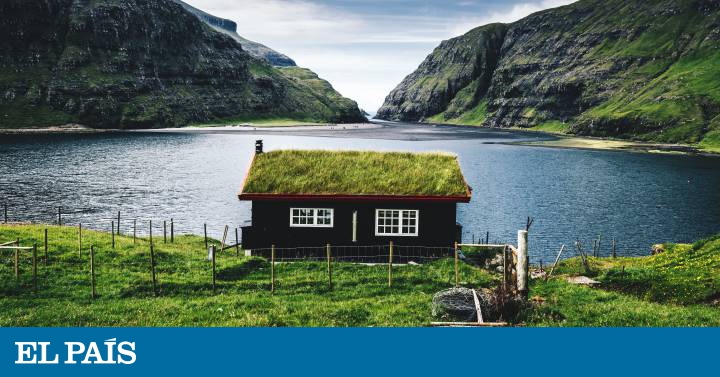1Mount Isola rises four hundred meters above the water of Lake Iseo, in Lombardy, northern Italy. In the summer of 2016 it was the scene of the artistic intervention 'Floating piers' by Christo and Jeanne-Claude, an amazing ephemeral orange-colored footbridge that connected Monte Isola and other islands in the lake with the towns on the shores. On this island without cars, the Santa Croce festival is celebrated every five years, in which the inhabitants of the town of Carzano cover the roads and streets with hundreds of thousands of colorful paper flowers. nicobrase GETTY IMAGES 2Astipálea (Greece) 'Petaluda' (butterfly) is what the Greeks call this island, the westernmost of the Dodecanese archipelago, since on the map, Astipálea has the shape of a lepidopteran with open wings. This territory of the Greek Aegean is kept safe, for now, from the large masses of tourists. The main port is Jora, with its white houses that go up the slope to the crest of the mountain. Here the town square offers shady terraces and magnificent views. Freeartist GETTY images 3Prócida (Italy) Ischia, Capri and Prócida form the most famous island trio in the Neapolitan archipelago. In Prócida, the smallest of the three, 'El postero y Pablo Neruda' (1994) was filmed. Beyond the port of Corricella, with its colorful houses attached to the hillside, and the cathedral of San Miguel Arcángel, are the sea and friendly and talkative people. Anyone looking for calm after the bustle of Naples has come to the perfect place. Westend61 Getty Images 4Schiermonnikoog (Netherlands) Schiermonnikoog is a refuge both for those who need to disconnect and for the more than 300 species of shorebirds that come every year to their marshes to reproduce. Seals can also be seen on some sections of the coast. Frans Lemmens Getty Images 5Kornati National Park (Croatia) There are landscapes so rare or beautiful that legends are needed to explain their origin. From the Kornati archipelago, on the Croatian coast, it is said that God, after creating the world, threw into the sea some white pebbles that were left over, thus creating this handful of 150 islands, islets and arid limestone rocks. It is precisely their austere beauty that makes them so attractive to hikers, boaters and divers. It is essential to bring drinking water, since there are no sources in them. Matjaz Boncina getty images 6Lofoten (Norway) Connected to each other by a single road, the Lofoten emerge between the turbulent waters of the Norwegian Sea, above the Arctic Circle, with the force of legendary landscapes: majestic mountains, deep fjords, seabird colonies and little towns like Hamnøy, where it smells like cod. Known as 'rorbu' and painted in deep red, the fishermen's huts function as rural lodgings and can serve as a base for kayaking, winter viewing of northern lights, diving or fishing. With just five hours of light a day in winter, these eight Arctic islands enjoy surprisingly mild temperatures for those latitudes thanks to the warm Gulf Stream. Misha Kaminsky Getty Images 7Guernsey (United Kingdom) French writer Victor Hugo (1802-1885) lived for more than 18 years on the English-speaking islands of Jersey and Guernsey, on the English Channel, fascinated by the light of these “little pieces of France fallen into the sea and collected by England ”. Guernsey, smaller than Jersey, has 63 square kilometers and 60,000 inhabitants. Rocky and with large sandbanks, the 13th-century Cornet Castle fortress defended the capital from maritime incursions and is now a museum. In addition to the Guernsey Museum, you can visit the Hauteville-House; During the 15 years he lived in this mansion, Hugo wrote "The Legend of the Centuries" (1857) and completed "Les Misérables" (1862). Allard Schage Getty Images 8Hiddensee (Germany) The almost 350 kilometers of the German Baltic coast, between Lübeck and Usedom, trace a little-known coastline, full of forests, lakes, ports, seaside architecture, large sandy areas and islands such as Hiddensee, which can only be explored on foot , by bicycle or on horseback. A refuge to relax among dune beaches, marshes and heather. picture alliance Getty Images 9Gozo (Malta) Anyone who knows Malta knows that when there is too much fuss on the big island, it is time to go to Gozo, the small neighboring island, accessible by ferry. Divers love this place, too, though not so much for the peace on the surface as for the diversity of underwater marine life. REDA & CO Getty Images 10Porquerolles (France) The Carmignac Foundation gathers around 300 pieces from the collection of a French millionaire on this French Riviera island. Porquerolles is the largest island of the three in Hyères, and is often filled with tourists during the day, so it is recommended to travel better out of season, and to be accompanied by the family. The absence of traffic, added to its small size, allows parents and children to camp freely and enjoy a quiet vacation. To move around the place, nothing better than renting a bicycle or just walking. Philippe ROYER Getty IMages 11Skellig Michael (Ireland) Skellig Michael is a 220 meter high steep mass of rock that emerges from the sea off the coast of County Kerry, Ireland. The island, which can only be visited from May to September, is famous for its appearance in two of the last episodes of the Star Wars saga -'The Force Awakens '(2015) and' The Last Jedi (2017) - and by the 'clochans' or stone cells of its solitary Celtic-style monastery, founded by Gaelic monks in the 6th century and declared a World Heritage Site by Unesco. Skellig Michael, like neighboring Little Skellig, is also home to bird species such as puffins, gannets, and ospreys. Charles McQuillan Getty Images 12Stockholm Archipelago (Sweden) Stockholm's unique garden of islets is only 80 kilometers from the city center. Swedes love this cluster made up of thousands of islets, many of them private, where the inhabitants of the Swedish capital like to retire on weekends and in the summer months. Tourists also long ago succumbed to the charm of these islets. Opting for kayaking is a great idea, although naturally it is also going for walks, angling or bathing. Lars Ruecker Getty Images 13Slinging Isles (United Kingdom) About 40 kilometers off the Cornish coast there is, in the middle of the Atlantic Ocean, an almost subtropical paradise. On the Isles of Scilly, pampered by the Gulf Stream, summers are warm and winters are mild, resulting in lush gardens such as those of Tresco Abbey, one of only five inhabited islands out of 140 in the archipelago. The largest, at 6.3 square kilometers, is St Mary's. It offers shops, beaches, pubs and summer freshness. Larigan - Patricia Hamilton Getty Images 14Hiiumaa, Saaremaa and Muhu (Estonia) Counting the islands of Estonia can take time. And it is that there are more than two thousand that are off the western coast of the country. Barely 19 are inhabited, but those who visit them will find open and friendly people. From Tallinn it is possible to go by car and ferry to Hiiumaa, Saaremaa and Muhu, waiting for someone to discover them, among pine forests and junipers, deserted beaches and places steeped in history. Ullar Hendla / EyeEm Getty Images 15Porto Santo (Portugal) Although it is a tiny piece of land in the middle of the Atlantic, barely eleven kilometers long by six wide, the island of Porto Santo is not alone: just 40 kilometers away is its neighbor Madeira, which gives its name to the archipelago. They are unequal sisters: while Madeira sports lush greenery, Porto Santo is as arid as it is fascinating, let alone touristy. A special site is Campo de Baixo beach, nine kilometers long and healing sands. A museum remembers that Christopher Columbus lived here for some years. simonbradfield Getty Images 16Belle-Île-en-Mer (France) The barnacle is, in addition to the title of one of the comics that appeared in the old 'TBO' ('13, rue del Percebe '), a tasty crustacean that lives anchored to the rocks of the coast, where the waves break more violently. It does not abound, and its collection is difficult and dangerous (as Galician 'barnacles' well know), hence its high price and the attraction that French gourmets have at Belle-Île-en-Mer, a beautiful island that honors its name: colorful houses, old alleys, cozy port cafes and quiet beaches, as well as pointed cliffs, white clouds and wild winds over the sparkling sea. Christophe Lemieux GETTY images Faroe Islands (Denmark) Less than 50,000 people and 80,000 sheep share the 18 islands that make up the Faroes, a Danish North Atlantic archipelago, between Scotland and Iceland, with landscapes as impressive as the Gásadalur waterfall, on a cliff above the sea. A territory that amazes with its emphatic nature, its slow pace of life and the most traditional Nordic culture, inherited from its Viking ancestors and summarized in the Faroese term 'hugni', something like homey warmth. Josh Hodge Getty Images 18 Arran (United Kingdom) Arran is the largest of the Clyde Fjord islands on the west coast of Scotland. With an area of 431 square kilometers and a population of about 4,600 people, its landscapes change drastically from north to south throughout its 32 kilometers: to the north, abrupt and mountainous; to the south, much softer. Is Arran the mystical Avalon of Arthurian legend, the land of the fairy queen? Contemplating its magical circles of menhirs it costs nothing to imagine. skeable getty images 19Tabarca (Spain) Tabarca, an island off the coast of Alicante, opposite Santa Pola, is so named because Genoese refugees expelled from the Tunisian city of Tabarka in the 18th century. Some went to Sardinia, where they still retain their dialect, while others settled in this piece of Alicante land, hence its sixty permanent residents have many Italian surnames. It is the smallest inhabited island in Spain, barely two kilometers long, in which around twenty beach bars are distributed in the summer, filling the hundreds of tourists that come and go by day by boat. Jose A. Bernat Bacete Getty Images 20Elba (Italy) One of the most interesting excursions that can be made from Livorno, on the Tuscan coast, is to the island of Elba, half an hour by ferry from the port of Piombino, where Napoleon was banished in 1814. The trail of Napoleon is found in the Museo Nazionale delle Residenze Napoleoniche, in Villa dei Mulini. Elba is the largest island in the Tuscan archipelago, to which the islands of Giglio, Capraia, Giannutri, Gorgona and the islet of Montecristo, known for appearing in the novel by Alejandro Dumas, 'The Count of Monte Cristo', also belong. The special thing about all these islands is their fascinating nature, protected thanks to the Tuscan Archipelago National Park. Culture Exclusive / WALTER ZERLA Getty Images
20 magical islands in Europe
2020-07-03T22:53:21.679Z

From Tuscan Elba, where Napoleon was exiled, to Lofoten, in the Arctic. Island territories that invite you to get lost









/cloudfront-eu-central-1.images.arcpublishing.com/prisa/KMEYMJKESBAZBE4MRBAM4TGHIQ.jpg)



